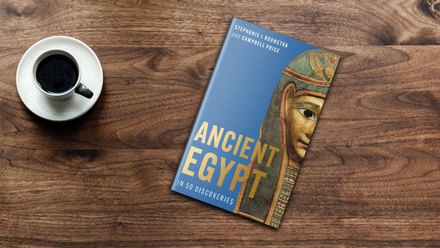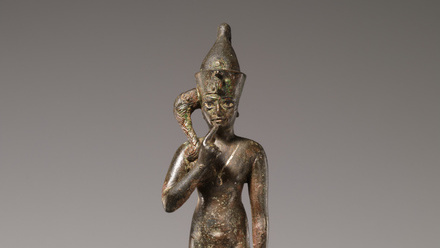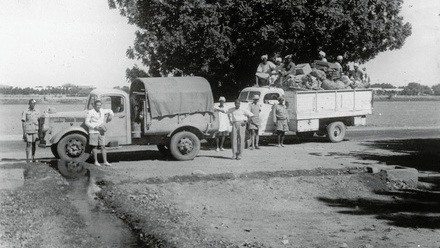Drawings along the Nile
The Aswan region is extremely rich in archaeological sites ranging from Prehistory to the Ptolemaic, Coptic and Islamic Periods. Since 2005, the Aswan-Kom Ombo Archaeological Project (AKAP), a joint venture between the University of Bologna and Yale University, has conducted archaeological surveys and excavations in selected areas north of the First Nile Cataract. AKAP’s concession includes a section of the West Bank of Aswan, two major wadis intersecting the valley from both sides – Wadi Kubbaniya and Wadi Abu Subeira – and a portion of the desert south-east of the Kom Ombo plain. Different datasets, including rock art, are recovered, documented, and analysed with extensive use of digital technologies. AKAP’s works have notably highlighted the complexity of cultural interactions in this vast “borderscape” during Prehistory and Antiquity, how it changed through time and how a regional scale, non-elite approach enriches our understanding of the ancient societies of Egypt and Nubia.
The West Bank has been the focus of a substantial part of AKAP’s early activities, especially the Sheikh Mohammed District where several rock art locations have been identified and partially documented at Gebel Qurna and Haggar el-Ghorab. If this rock art is mainly attributed to pre-Pharaonic periods, inscriptions, and drawings from all phases of Egyptian history are also attested. These productions are crucial testimonies of human occupations and activities in the area; they constitute a dataset which has the potential to complement already available archaeological records.
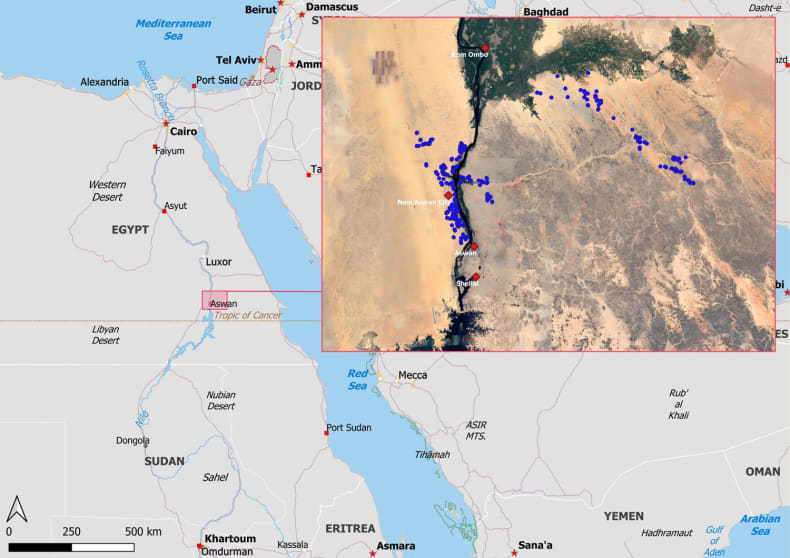
Archaeological sites and rock art stations identified inside AKAP’s archaeological concession
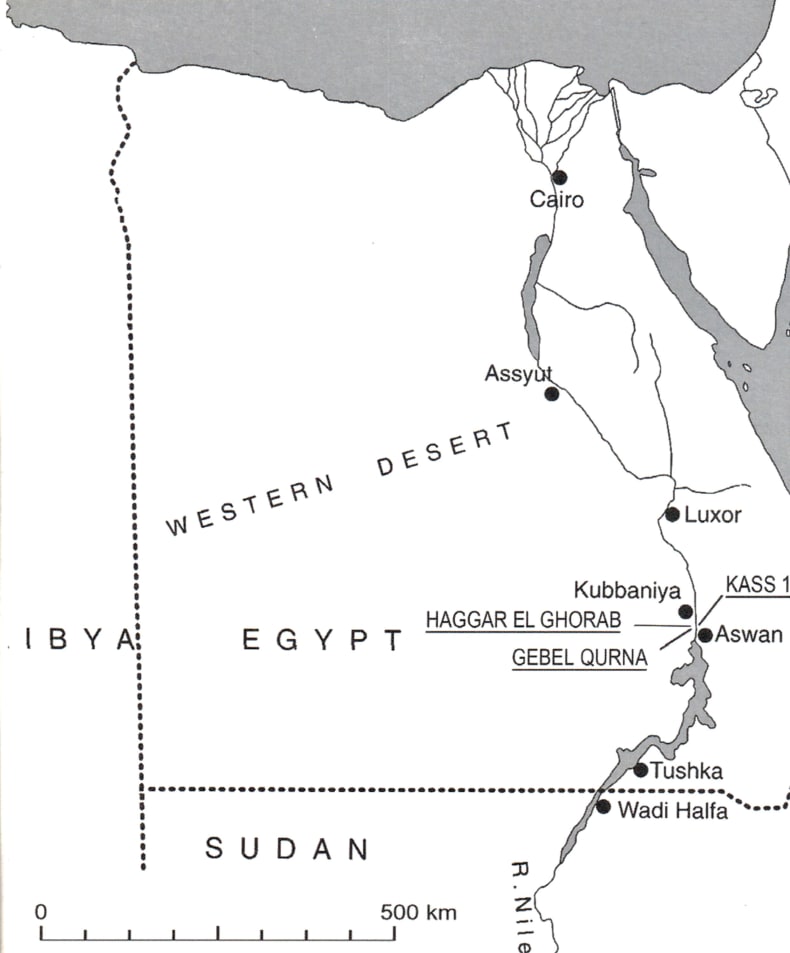
Location of Haggar el-Ghorab and Gebel Qurna
Predynastic/A-Group, Middle Kingdom/C-Group and Byzantine cemeteries were excavated in the Sheikh Mohamed District by H. Junker a century ago. Among the various sites identified in the area, Wadi Kubbaniya is undoubtedly the one which attracted much of the attention for its outstanding Late Palaeolithic archaeological record. The place then remained quite unexplored for decades before the development of AKAP’s activities in the region. The increase in construction, land reclamation, and quarrying/mining activities along the Nile and in the desert hinterlands is threatening many of these sites, adding significance and urgency to archaeological research in the area. In this context, the current construction of the city of New Aswan on the West Bank leads to new challenges, especially regarding the preservation of rock art. Indeed, beside a few impressive and partially documented panels scattered in the area, many engravings remain to be properly processed and published. Without such scientific recognition, this often underestimated, and poorly protected archaeological evidence runs the risk of being irremediably lost.
Gebel Qurna is an elongated sandstone hill, oriented N-S and located at the southern fringe of the Sheikh Mohamed district. Highly engraved following diverse techniques from Prehistory to Roman times, this landmark served as quarries in Ptolemaic times and still do today on its western part.
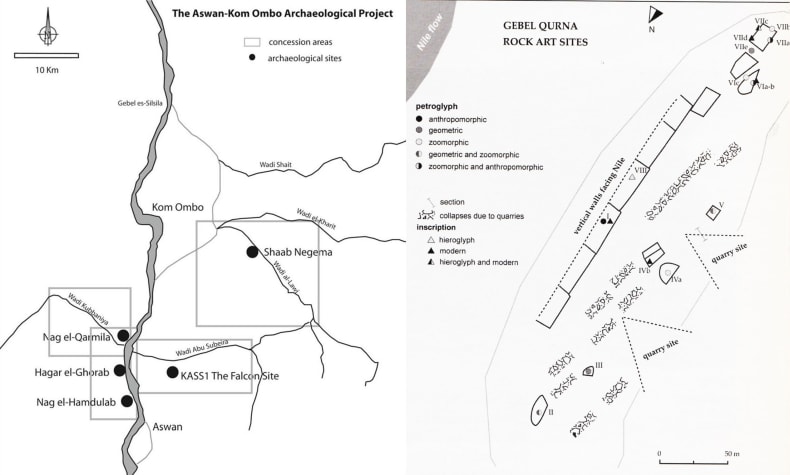
Location and spatial repartition of Gebel Qurna rock art sites in the Sheikh Mohamed District
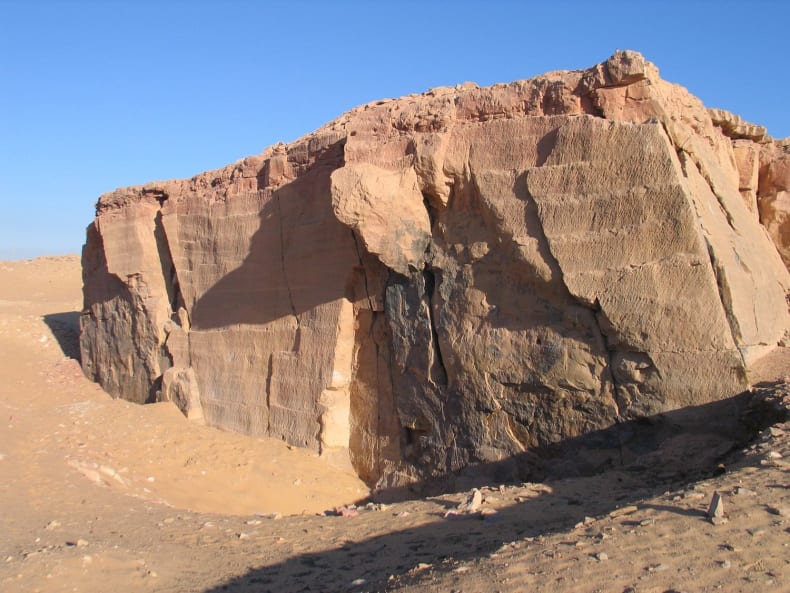
Quarries south of Kubbaniya (© AKAP, 2008)
Haggar el-Ghorab, also an important landmark bordering the Nile, consists of a section of the gebel wall close to the modern Aswan Bridge, south of Kubbaniya. Its boulders form small shelters continuously occupied from the Predynastic until the Coptic period. If quarrying activities are not attested at Haggar el-Ghorab, this area counts among the most threatened by the construction of the New Aswan City.
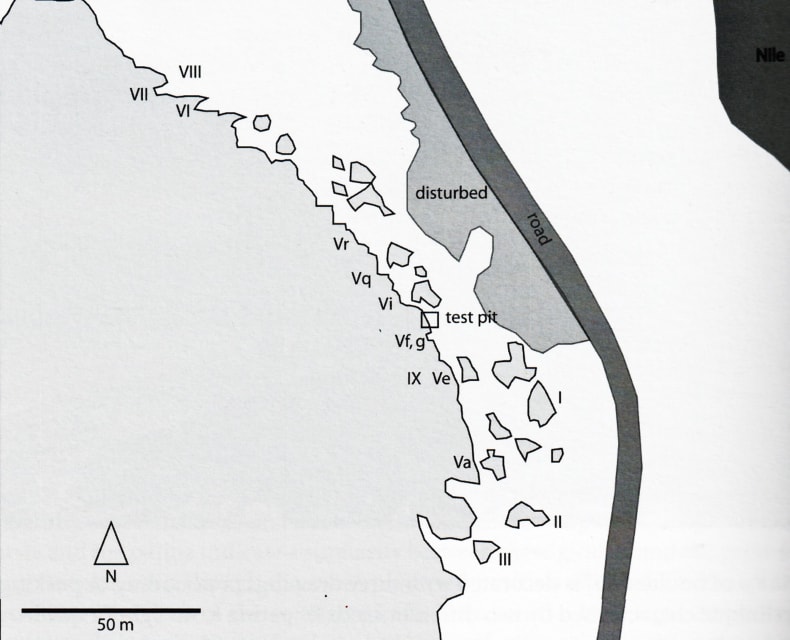
Spatial repartition of Haggar el-Ghorab rock art sites in the Sheikh Mohamed District
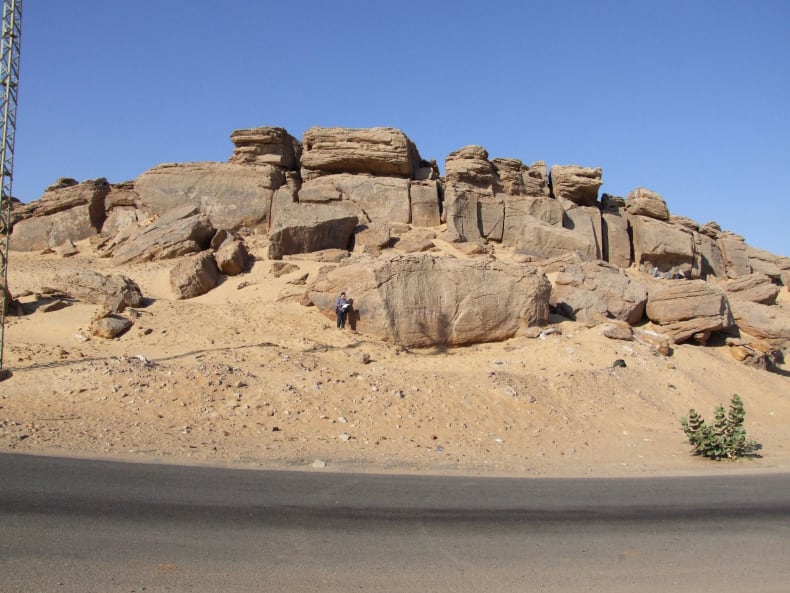
Front view of Haggar el-Ghorab (© AKAP, 2008)
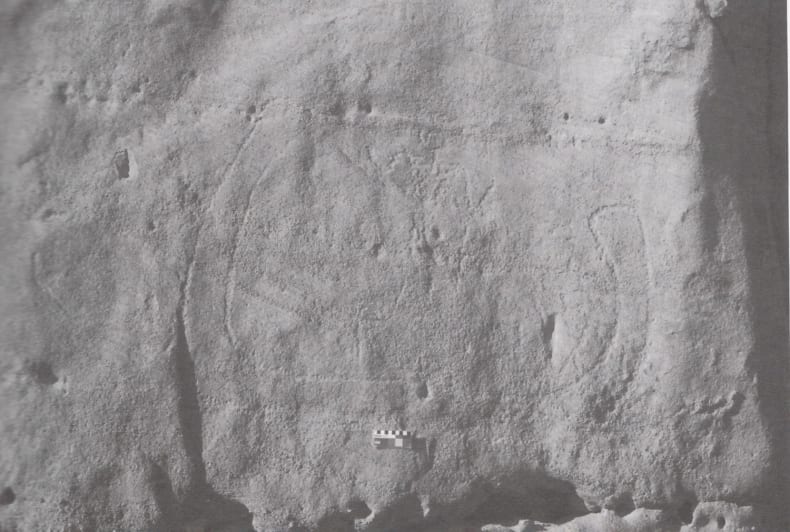
Naqada IIIA-B boat with a human figure at Haggar el-Ghorab (© AKAP; Gatto et al. 2009, 157, fig. 10)
This project aims to resume the preliminary investigations conducted in the Sheikh Mohammed District between 2005 and 2009 in order to comprehensively document, process and publish both the rock art and the inscriptions endangered by modern urbanism. It will take place alongside the AKAP archaeological work and both teams will act in synergy inside a highly interdisciplinary environment.
Because several panels are still partly, if not completely, covered with sand, limited archaeological investigations are also intended. These excavations will mainly consist of the complete cleaning of the panels prior to their documentation. The possibility of conducting OSL analysis of the sediment covering the engravings, a technique already used with success on Palaeolithic productions at Qurta, will be evaluated. Rock art recordings will benefit from modern techniques involving photogrammetry and digital drawing, so to comply with Egyptian regulations which now prohibit the application of plastic sheets on rock surfaces. Such techniques, developed by A. Urcia, has already been used successfully by AKAP and the Elkab Desert Survey Project directed by J.C. Darnell (Yale University). It consists of a complete photogrammetric covering of each decorated panel and the transfer of the collected and processed data into a drawing application which can be used on a tablet directly on site.
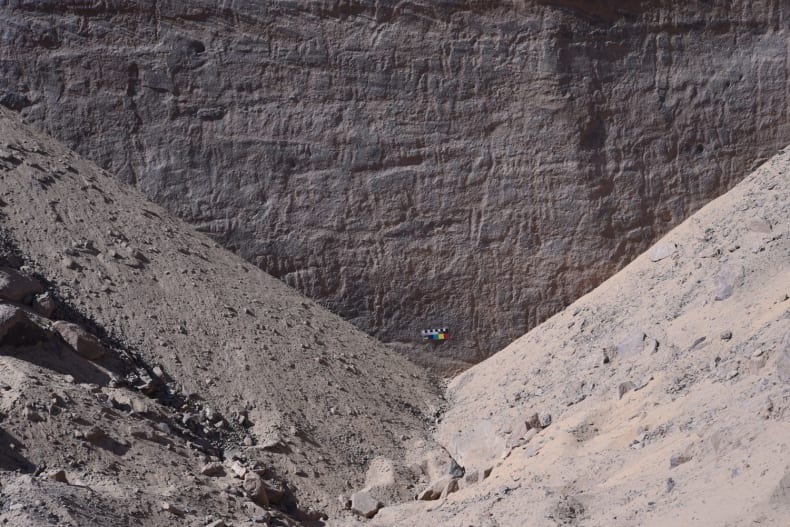
Complex panel originally completely recovered by sand. This picture shows its partial cleaning by AKAP in 2020 (© AKAP)
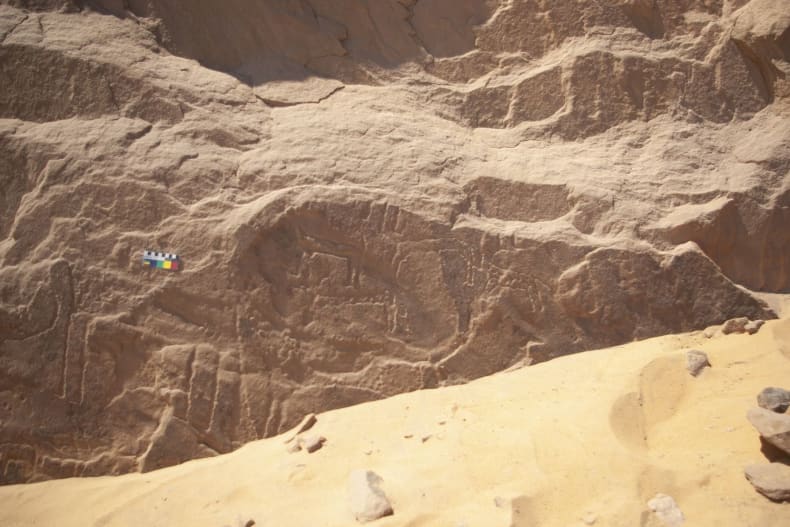
Prehistoric rock art still partially covered by sand in Shiha (© AKAP)
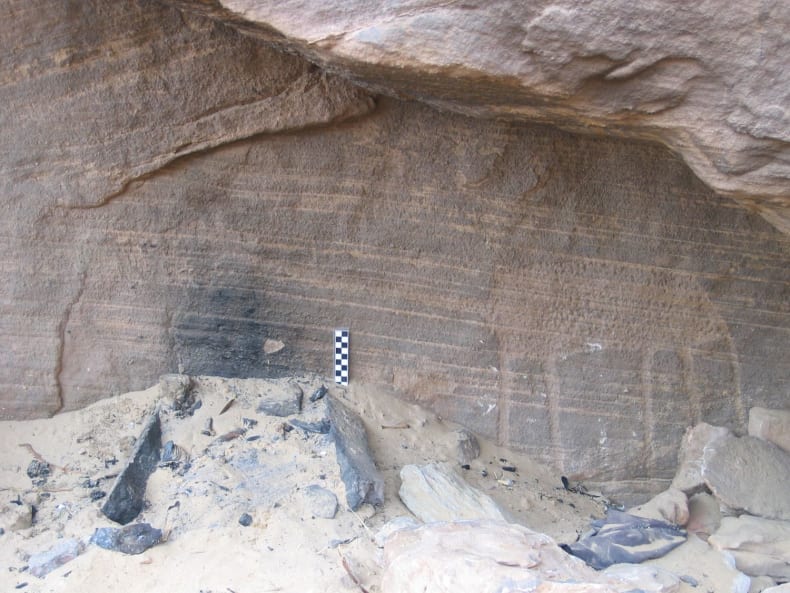
Engraved giraffe partially covered by aeolian sand and rubble at Gebel Qurna (© AKAP)
The strong salvaging and documenting dimension of this mission, which is urged by the Egyptian authorities, cannot be underestimated. Among its main objectives, this project has the difficult task to identify the sectors that must be preserved and included in the urban plans of New Aswan City, and to draw up didactic panels in prevision of the construction of a corniche road conceived for welcoming tourists.
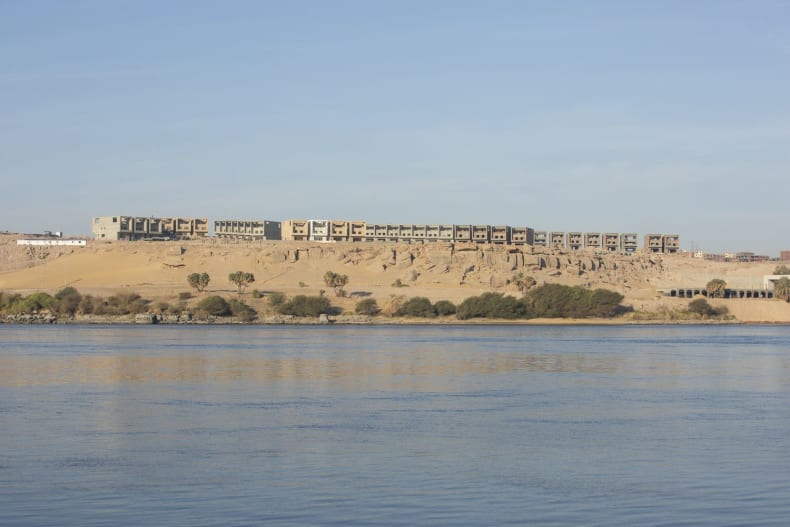
Modern constructions at the top of the gebel at Sheikh Mohammed (© AKAP, 2019-2020)
The mission, which is planned to take place in November 2022, hopes to pave the way to a more systematic and holistic survey of the West Bank of Aswan and to advocate for the preservation of all rock art productions in Egypt. Rock art studies are indeed experiencing a strong renewal: new research paradigms and methodologies, recordings techniques and theoretical approaches are currently being developed and they will ensure a better documentation and interpretation of rock art in the near future.
Further reading
Huyge, D. 2009. ‘Rock Art’. In : Willeke W. (ed.). UCLA Encyclopedia of Egyptology, Los Angeles, 1-13. https://escholarship.org/uc/item/4qx7k7pz [11/06/21].
Gatto, M.C. et al. 2009. ‘Archaeological Investigation in the Aswan-Kom Ombo Region (2007–2008)’, Mitteilungen des Deutschen Archäologischen Instituts. Abteilung Kairo 65, 9-57.
Gatto, M.C. et al. 2009. ‘Rock Art from West Bank Aswan and Wadi Abu Subeira’, Arche?o-Nil 19, 151-168.
Hendrickx S. et al., 2012. ‘Iconographic and Palaeographic Elements Dating a Late Dynasty 0 Rock Art Site at Nag el-Hamdulab (Aswan, Egypt)’. In: Huyge D. et al. (eds), The Signs of Which Times ? Chronological and Palaeoenvironmental Issues in the Rock Art of Northern Africa, held at the Royal Academy for Overseas Sciences (Brussels, 3rd-5th June 2010), Brussels, 295-326.
Huyge, D. 2002. ‘Cosmology, ideology and personal religious practice in ancient Egyptian rock art’. In: Friedman, R.F. (ed.), Egypt and Nubia. Gifts of the desert, London, 192-206.
Junker, H. 1919. Bericht über die Grabungen von der Akadamie der Wissenschaften in Wien, auf den Friedhöfen von El Kubanieh - Sud. 1910-1911 (DAWW 62.3), Vienna.
Polkowski, P. 2020. ‘World of Images or Imaginary World? Rock Art, Landscape and Agency in the Western Desert of Egypt’. In: Dirksen S., Krastel L. (eds). Epigraphy through Five Millennia: Texts and Images in Context (Sonderschrift des Deutschen Archäologischen Instituts, Abteilung Kairo 43), Cairo, 255-284.
Urcia, A. et al. 2018. ‘From Plastic Sheets to Tablet PCs: A Digital Epigraphic Method for Recording Egyptian Rock Art and Inscriptions’, African Archaeological Review 35/2, 169-189.
Online resources
https://www.borderscapeproject.org/
https://egyptology.yale.edu/expeditions/current-expeditions/elkab-desert-survey-project-edsp

